
Lindberg 1/48 Bristol Bulldog
|
KIT # |
917 |
|
PRICE: |
$2 at a swap meet |
|
DECALS: |
rub-down transfers |
|
REVIEWER: |
Pierre-Andre Boillat |
|
NOTES: |
Ex-Inpact/LifeLike/Pyro kit. |

|
HISTORY |
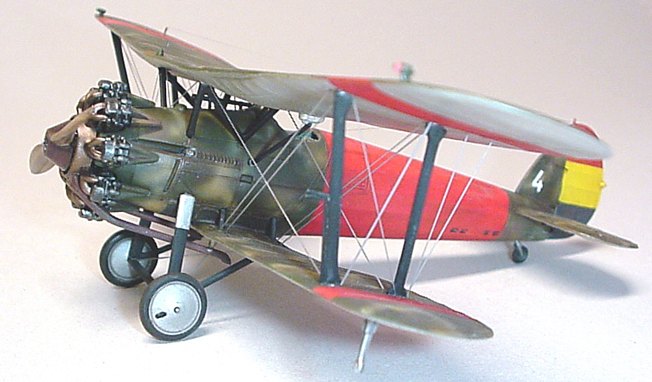
Based on an Air Staff specification of 1924 (modified in ’26) asking for a high-speed, fast-climbing biplane long-range fighter, the Bristol Bulldog Mk II prototype (no Mk I was produced), designed by Frank Barnwell, had its first flight on January the 21st, 1928 with Cyril Uwins at the controls. Having won the evaluation against the Hawker Hawfinch, Bristol’s new fighter was ordered into production, a first batch of 25 machines entering service with No.3 and 17 (fighter) Sqs the same year.
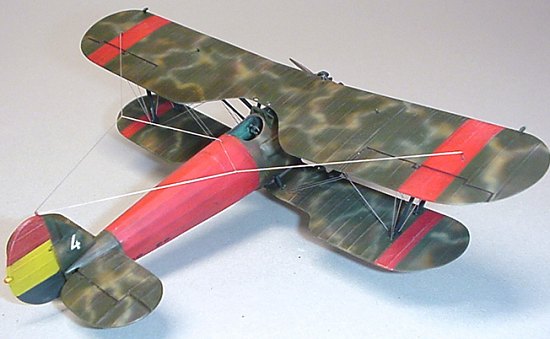 Equipped with a
Bristol Jupiter VII F radial engine of 440 HP, the Bulldog IIA had a
maximum speed of 174mph, which was quite fast for the time. Besides, its
superb manoeuvrability and ease of handling made it very popular with its
pilots. All in all, 441 of all marks were produced for the RAF and - due
to its cheap retail price of 4’800£ - several foreign customers (like
Sweden, Siam, Latvia, Japan, Danemark and Finland, one machine
being tested by the US Navy). Except for the Finnish machines that did
fight the Soviets during the Winter War (and the Spanish ones being the
subject of this review), the Bulldog enjoyed a rather quiet peacetime
career during the late 20’s and early 30’s, the RAF machines being phased
out between 1933 and 1937, in favour of more “modern” designs like the
Hawker Fury or the Gloster Gauntlet/Gladiator.
Equipped with a
Bristol Jupiter VII F radial engine of 440 HP, the Bulldog IIA had a
maximum speed of 174mph, which was quite fast for the time. Besides, its
superb manoeuvrability and ease of handling made it very popular with its
pilots. All in all, 441 of all marks were produced for the RAF and - due
to its cheap retail price of 4’800£ - several foreign customers (like
Sweden, Siam, Latvia, Japan, Danemark and Finland, one machine
being tested by the US Navy). Except for the Finnish machines that did
fight the Soviets during the Winter War (and the Spanish ones being the
subject of this review), the Bulldog enjoyed a rather quiet peacetime
career during the late 20’s and early 30’s, the RAF machines being phased
out between 1933 and 1937, in favour of more “modern” designs like the
Hawker Fury or the Gloster Gauntlet/Gladiator.
The Spanish Bristol Bulldogs
During the Spanish Civil War, the Republican government, desperately seeking for every aircraft available, managed to buy 5 ex-Latvian Bulldogs, with the help of Czechoslovakia acting as the “official” purchaser (a practice still common in matters of international arms trading). However, the Bristols being already obsolete in 1936/37, they were relegated to strafing duties along with other second-hand old “crates”, this ragtag assembly of vintage machines forming a unit nicknamed the “Krone Circus” (after a then-famous european Circus, which says a lot about their pilots’ feelings !). Flown by foreign volunteers of the International Brigades, the 5 Bulldogs fought the furious battles on the north-western front (Basque Country and Asturias) – with no memorable success, however. Their eventual fate is unknown, except for one that was captured intact by Nationalist troops on Santander airfield.
2010 update: Alex Crawford writes;
|
THE KIT |
You know, there’s something
really nice about younger modelers – sometimes, they have no clue about
the kind of gems you can find on a vendor’s table (sorry kids, no offence
meant...). When I saw this one at the IPMS Switzerland convention 2 years
ago, on sale for the ridiculous price of three Swiss Francs, I seriously
asked myself why it was still there waiting for me
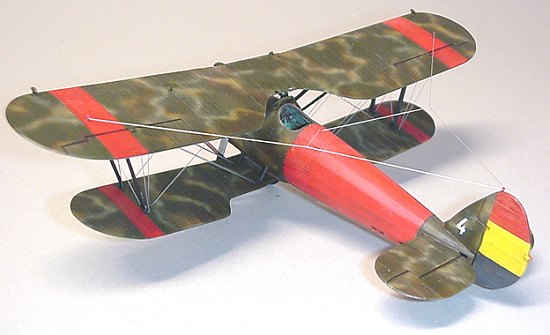 after half a day !
But of course, one must admit there was no famous Japanese brand on the
poorly designed box, it wasn’t a Luftwaffe or US Navy aircraft… and,
worst of all, it was a BIPLANE ! Needless to say I grabbed this Bulldog
at once, thus purchasing my cheapest kit in 20 years…
after half a day !
But of course, one must admit there was no famous Japanese brand on the
poorly designed box, it wasn’t a Luftwaffe or US Navy aircraft… and,
worst of all, it was a BIPLANE ! Needless to say I grabbed this Bulldog
at once, thus purchasing my cheapest kit in 20 years…
So, what’s in the box ? First, you can have a look at Scott’s preview on this excellent website (… you’re welcome, skipper !)… then, I can give you my very own impression free of charge : when it was first released by Inpact in the mid-sixties, this kit must have been a glorious vision to the happy modelers – given they cared about accuracy, clean molding techniques, fine surfaces and details back in the Days of Old – as for myself, I didn’t : I just wanted to play with the stuff ! The point which must have made this model popular is the ease of assembly, which is outright stupendous. It’s a pity Inpact went down in 1968, but with classic British subjects like the Bulldog, Fury, Gladiator or Flycatcher, it’s no wonder: just not enough Messerschmitts in the range, I guess… Anyway, the Inpact kits were later reissued by LifeLike, Pyro and Lindberg, which shows that there is still a demand for unusual airplanes of the Golden Era of aviation.
|
CONSTRUCTION |
As said above, the Bulldog is a real
pre-shake-and-bake one. I just added some stretched sprue in the cockpit
to simulate the tubular framing, and assembled the rest OOB. The only fit
problem you encounter is a tricky main wing assembly (left- center-right),
which will demand some filling and sanding (look out for the fabric
structure !). The large and complicated engine being the “star of the
show”, I assembled, painted and weathered it separately, then glued it to
the airframe after all painting was done. Of course, as with any biplane,
the upper wing and landing gear get the same treatment, and are to be
assembled last. To those who never tried one, I’d like to give this
advice : build it as a monoplane, and put it together when it’s finished.
center-right),
which will demand some filling and sanding (look out for the fabric
structure !). The large and complicated engine being the “star of the
show”, I assembled, painted and weathered it separately, then glued it to
the airframe after all painting was done. Of course, as with any biplane,
the upper wing and landing gear get the same treatment, and are to be
assembled last. To those who never tried one, I’d like to give this
advice : build it as a monoplane, and put it together when it’s finished.
The final details
The wheels are very nicely
detailed… True, the profiles of Spanish Bulldog No.2 (the only one
available to my knowledge) show uncovered, spoked ones – hence, I decided
to make No.4 (maybe someone can prove me wrong… nobody ?... OK !). The
landing gear and exhaust pipes assembly is quite easy and will be done in
no time (let it dry overnight, however). The propeller can be assembled
with or without the pointed spinner (I left it out, as it seems it was
only present on RAF machines). Transparencies consist of a single part: a
small, thick windshield. More caring modelers will want to replace it
with a thinner one, but , as it’s hidden under the main wing, I admit I
didn’t.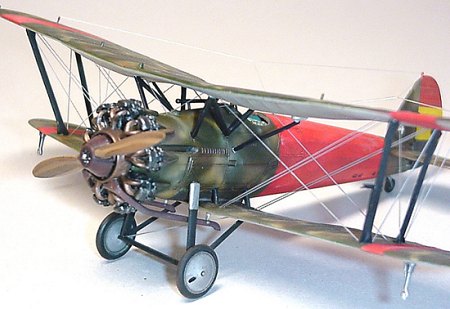
The main event on a biplane model…
Last but not least came the thing which makes lots of modelers step back in horror : rigging. Well, if the “wind in the wires” romantic is true, Bulldog pilots must have heard quite a music flying this machine ! Wires here, wires there, even double-wires… talk about a “stringbag”!.. Anyway, the kit sports conveniently placed little holes which are supposed to be drilled through by those who still practice the complicated “one thread all over the plane” method. As I’m a strong supporter of the stretched sprue, glued in place, then heated straight with a glowing toothpick, I used the holes for precise location. As (according to the few Bulldog pics available) the wires were metallic gray, I just used the kit’s sprues and left them unpainted. Only the large, exposed antenna wires were made from “stretch” rubber sewing thread – for security reasons, as I don’t want to change them after every exhibition !
|
CAMOUFLAGE & MARKINGS |
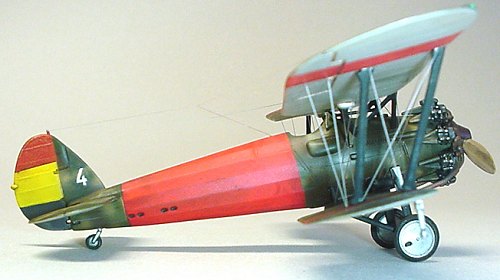 The main shortcoming of
my Lindberg Bulldog is that it only provides a set of rub-down, Letraset-type
transfers, which, adding insult to injury, were off-register ! Having
built an Airfix 1/72 Bulldog in my early modeling years as a Spanish
Republican, I decided to do the same in 1/48. The machines (according to
the very few sources available) got a field-applied camo of light
brown/sand over some olive green, with the wing undersides being left in
the original aluminium dope. The four wings and the fuselage wear red
bands (the latter one going from the fin to the cockpit), and rudder
sports the Republic’s colours of red, yellow and mauve (blueish violet).
No decals were used except for the small number 4 on the fin. As usual
with me, Tamiya acrylics (thinned with alcohol) were airbrushed with a
Harder&Steenbeck “Focus”. A wash of umbra oils was made prior to a coat
of Model Master flat, some details being enhanced by a drybrushing of
pastel chalk powder.
The main shortcoming of
my Lindberg Bulldog is that it only provides a set of rub-down, Letraset-type
transfers, which, adding insult to injury, were off-register ! Having
built an Airfix 1/72 Bulldog in my early modeling years as a Spanish
Republican, I decided to do the same in 1/48. The machines (according to
the very few sources available) got a field-applied camo of light
brown/sand over some olive green, with the wing undersides being left in
the original aluminium dope. The four wings and the fuselage wear red
bands (the latter one going from the fin to the cockpit), and rudder
sports the Republic’s colours of red, yellow and mauve (blueish violet).
No decals were used except for the small number 4 on the fin. As usual
with me, Tamiya acrylics (thinned with alcohol) were airbrushed with a
Harder&Steenbeck “Focus”. A wash of umbra oils was made prior to a coat
of Model Master flat, some details being enhanced by a drybrushing of
pastel chalk powder.
|
CONCLUSIONS |
It was a strange thing to build a kit which is almost as old as I am… However, the amazing qualities of the Inpact/Pyro/LifeLike/Lindberg Bristol Bulldog made this project a real pleasure. Superdetailers should be able to turn this correct and well-designed kit into a contest-winner. If you're fascinated by the charm of the classical 20’s and 30’s aviation, or if you look for a good and cheap starter in biplane models (provided you’re not afraid to do a lot of rigging), this one’s for you. It shouldn’t be too difficult to find one at some swap shop. Good luck !
|
REFERENCES |
„Aero – das illustrierte Sammelwerk der Luftfahrt” – No.139.
„L’Espagne en guerre“ – Editions Fleurus, 1981.
« Avions de combat 1919-1939 », Editions Atlas.
November 2003
Copyright ModelingMadness.com
If you would like your product reviewed fairly and quickly, please contact the editor or see other details in the Note to Contributors.